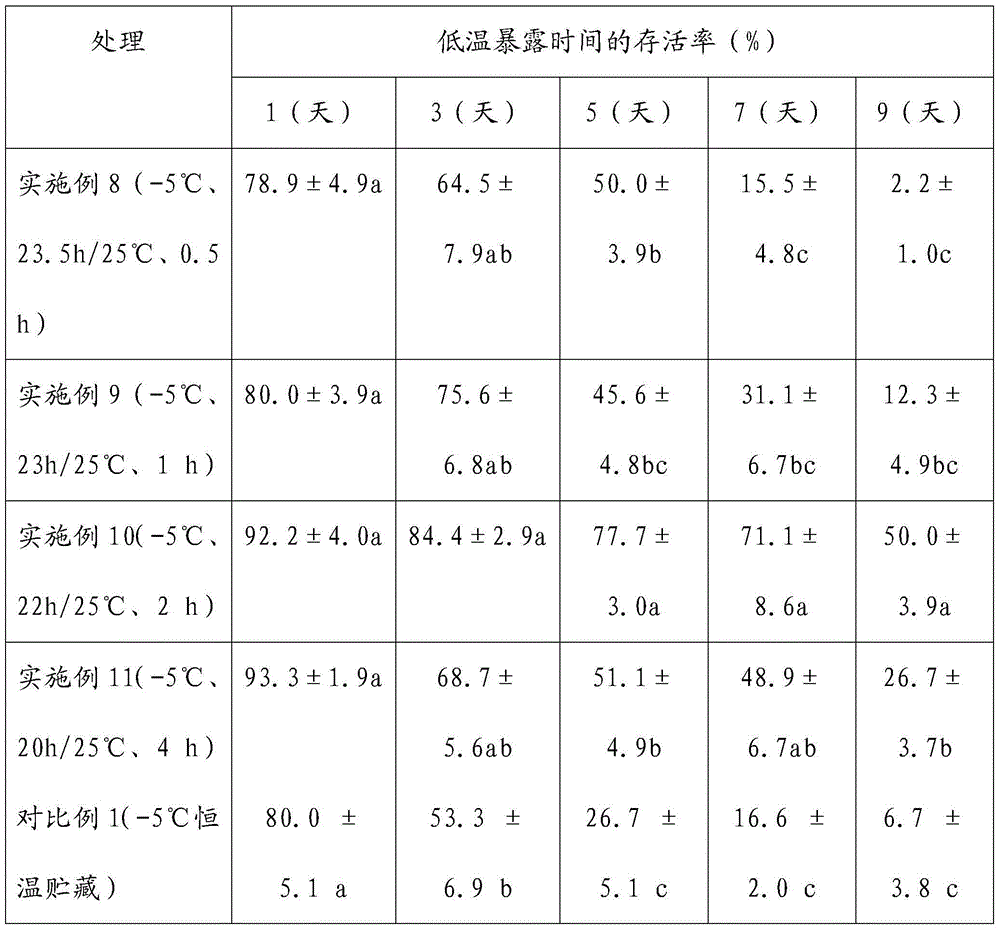Low-temperature storage method for artificial propagation of harmonia axyridis
The invention relates to a technology for cryopreservation of lady beetles, which is applied in the field of low temperature storage of artificially propagated and reproduced adults of lady beetles, and can solve the problems of prolonged storage time and the inability of the biological characteristics of lady beetles to satisfy long-term storage and transportation, and the like. To achieve the effect of improving the survival rate
- Summary
- Abstract
- Description
- Claims
- Application Information
AI Technical Summary
Problems solved by technology
Method used
Image
Examples
Embodiment 1
[0021] In order to exclude the influence of cold-shock on the low-temperature survival of H. heterochromia, the artificially multiplied H. heterochromia adults were exposed at 10°C for 24 h, and then moved into a colorless translucent plastic box (15 cm × 10 cm × 7 cm ), the plastic box is covered with a parafilm, and a number of ventilation holes are pierced on the parafilm.
[0022] The Heterochromia was moved into a plastic petri dish and stored under low temperature exposure at 0°C for 1 week, in which the high temperature exposure was intermittently exposed at 5°C for 0.5h every day.
[0023] After the end of low-temperature and intermittent high-temperature storage, H. heterochromia was transferred to rearing conditions to recover for 24 hours, and the surviving adults with walking coordination were screened.
Embodiment 2
[0025] In order to get rid of the impact of cold shock (cold-shock) on the low-temperature survival of ladybugs, artificial propagation (the breeding condition of artificial propagation is 24 ℃ at temperature, humidity is 60%, photoperiod L:D=16h :8h) H. heterochromia adults were exposed at 10°C for 24h, and moved into a colorless translucent plastic box (15cm×10cm×7cm). air vent.
[0026] Heterochromia was moved into a plastic petri dish and stored at -2°C for four weeks, with intermittent high temperature exposure at 15°C for 1 hour every day.
[0027] After storage at low temperature and intermittent high temperature, the ladybugs were transferred to rearing conditions (T=24°C, photoperiod L:D=16h:8h) to recover for 24 hours, and surviving adults with coordinated walking were screened.
Embodiment 3
[0029] In order to get rid of the impact of cold shock (cold-shock) on the low-temperature survival of ladybugs, artificial propagation (the breeding condition of artificial propagation is that temperature is 26 ℃, humidity is 70%, photoperiod L:D=16h :8h) H. heterochromia adults were exposed at 10°C for 24h, and moved into a colorless translucent plastic box (15cm×10cm×7cm). air vent.
[0030] The Heterochromia ladybugs were moved into plastic petri dishes and stored under low temperature exposure at 5°C for 2 weeks, with intermittent high temperature exposure at 30°C for 2 hours every day.
[0031] After the H. heterochromia has been stored at low temperature and intermittent high temperature, it is transferred to the feeding condition (T=26°C, photoperiod L:D=16h:8h) to recover for more than 24 hours, and the surviving adults with coordinated walking are screened.
PUM
 Login to View More
Login to View More Abstract
Description
Claims
Application Information
 Login to View More
Login to View More - R&D
- Intellectual Property
- Life Sciences
- Materials
- Tech Scout
- Unparalleled Data Quality
- Higher Quality Content
- 60% Fewer Hallucinations
Browse by: Latest US Patents, China's latest patents, Technical Efficacy Thesaurus, Application Domain, Technology Topic, Popular Technical Reports.
© 2025 PatSnap. All rights reserved.Legal|Privacy policy|Modern Slavery Act Transparency Statement|Sitemap|About US| Contact US: help@patsnap.com



